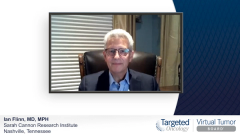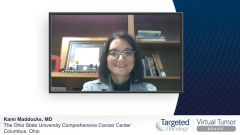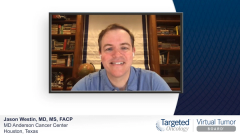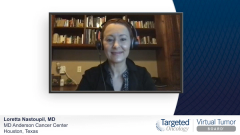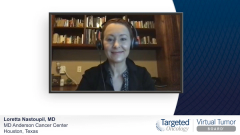
Case 3: Later-line Options to Treat Double-Hit DLBCL
Kami Maddocks, MD: Here we have a patient who’s a little older than the first patient, younger than the second patient. Age, however, if this was a healthy 72-year-old, probably still a candidate for curative therapy. This patient’s issue may be more in that they have some cardiomyopathy, not a horrible ejection fraction [EF] but lower, and renal insufficiency. So more than 1 comorbidity.
What are the challenges in treating this patient? In the first-line setting, say this patient had a lower EF,of 30%. What are options in that setting? And then in this patient, what are options in second- and later-line settings when maybe they can get R-EPOCH [rituximab plus etoposide, prednisone, vincristine, cyclophosphamide, hydroxydaunorubicin] or R-CHOP [rituximab plus cyclophosphamide,hydroxydaunorubicin, vincristine,prednisone] for frontline treatment, but then struggle with the comorbidities in later treatment?
Jason Westin, MD, MS, FACP: This is not an uncommon scenario in our clinic, to have a patient who has these comorbidities of mild heart dysfunction, mild renal dysfunction. What I would note is the patient was able to tolerate dose-adjusted R-EPOCH [rituximab plus etoposide, prednisone, vincristine, cyclophosphamide, hydroxydaunorubicin], so they’ve kind of declared themselves able to tolerate a relatively aggressive frontline approach.
EPOCH [etoposide, prednisone, vincristine, cyclophosphamide, hydroxydaunorubicin] is not super toxic. It’s easy for me to say that, I’m not the one receiving it, but it’s slow infusion chemotherapy. So I don’t think this is something we need to shy away from, to try for a cure in a patient like this who’s got double-hit lymphoma. You can always start at a lower dose. It’s dose-adjusted. Dose adjusting is a 2-way street, you can go up or down. Sometimes we’ll start at a lower dose and escalate up to full dose in somebody we’ve had concerns about.
The challenges in patients who have heart dysfunction or renal dysfunction go beyond which chemotherapy to choose. It’s what do you do after chemotherapy? If this patient had achieved a complete response to GDP [gemcitabine, dexamethasone, cisplatin], they might have had a challenge to go on to receive an autologous transplant. Some transplant centers have hard cutoffs for ejection fraction or creatinine clearance. This is a patient where CAR [chimeric antigen receptor] T-cell therapy and/or targeted approaches likely will be better tolerated than further aggressive platinum chemotherapy.
Transcript edited for clarity.



